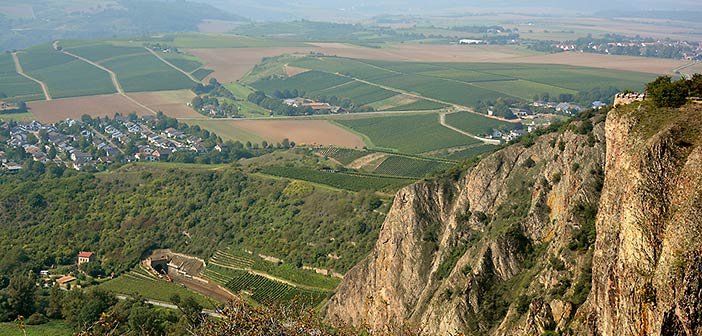Germany’s seventh-largest wine region, Nahe is not as well known as neighboring Rheingau or Rheinhessen. But the regions small-scale wine-making culture, with its almost 180 different soils, respect for the know-how of the fathers and an open attitude to the future – Nahe is certainly worth a visit.
It takes just over half an hour to drive from Frankfurt to the Nahe wine region, but in that time the landscape is transformed from a city of a million inhabitants into a picturesque, rolling valley of the Nahe River, dotted with centuries-old villages and churches. The capital and heart of the Nahe, the spa town of Bad Kreuznach, is also a sleepy market town where you can feel time stand still in the stunning riverside parks.
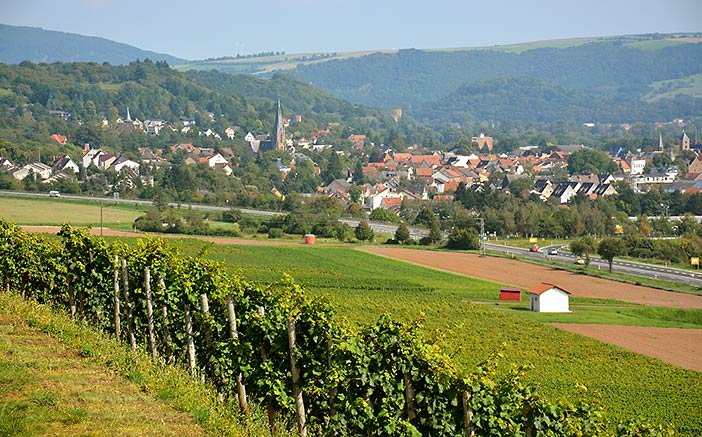
Nahe has partly a Mediterranean climate
With the Hunsrück Mountains sheltering it from northern winds and rain, the Nahe enjoys a warm climate and a long growing season. In the lower reaches of the Nahe, there are parcels of land that are said to have a micro-climate that even resembles that of the Mediterranean. The Nahe’s rainfall of 722mm per year is ‘only’ Helsinki’s, but like us, the years are not brothers. This year, for example, Nahe has already received a lot of water.
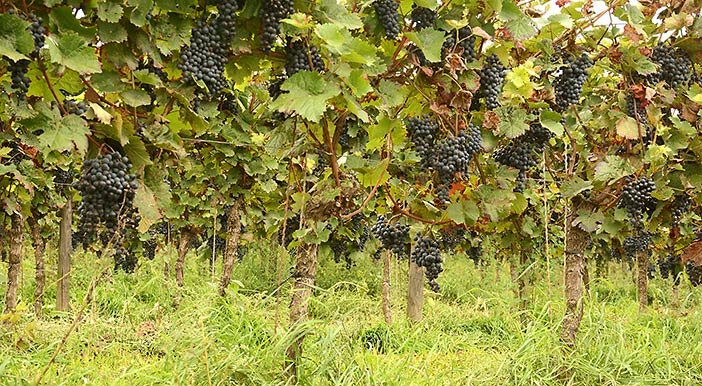
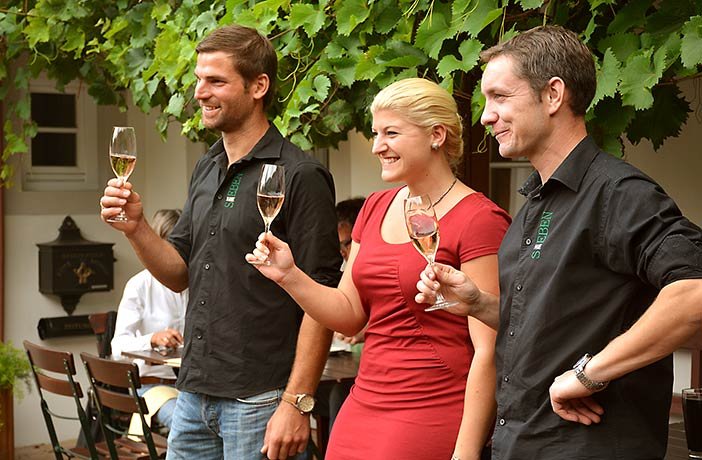
As one young farmer put it, “Many of us have had enough of Nahe at some point; it always rains. Always the frosts come too early. Frustrated, we leave to try our wings in California and Australia.
Nahe is the seventh largest of Germany’s 13 classified (Anbaugebiete) wine regions, with 4,100 hectares under cultivation. The area under red grapes in Germany in general is increasing, already 35%, but Nahe wines are still made from 75% white varieties, mainly; Riesling, Silvaner, Pinot Blanc and Pinot Gris.

“Near wine regions” by Lantus/Agne27 – Own work (Lantus). Licensed under CC BY-SA 3.0 via Wikimedia Commons.
The promised land of Pinot wine
Riesling is the most cultivated grape variety in the Nahe, but in terms of total area under vines, the Pinot variety is taking over. For me, the biggest surprise came from the Pinot Gris or Grauburgunder wines, which were truly memorable. With or without oak.
I was also impressed by the elegant approach of several of Nahe’s Spätburgunder. In Germany, this delicate variety is often filled with oak that makes you want to carve the wine with an axe, but Nahe’s young winemakers have clearly understood what Pinot Noir is all about. A good example is the Weingut Barth Spätburgunder No.1 -im Barrique gereift that went home with them.
Pinot family in German:
Pinot Blanc = Weissburgunder
Pinot Gris = Grauburgunder
Pinot Noir = Spätburgunder
Pinot Madeleine = Frühburgunder
Zwölberich – Nearby organic farmer
The Zwölberich farm is located near the Rhine River, in the village of Langenlonsheim. The farm has been in the family since the early 1700s, so there is a long tradition of wine making in Nahe. Over the centuries, Zwölberich has managed to acquire a comprehensive catalog of parcels in different soils so that every grape variety has an optimal growing medium.
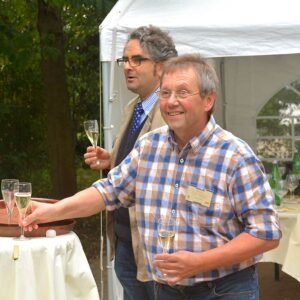

Zwölberich in a nutshell
- 33 hectares
- 250,000 bottles per year
- White varieties: Riesling, Grauburgunder, Silvaner, Auxerrois, Weißburgunder, Würzer, Rivaner, Kerner
- Red wines: Spätburgunder, Frühburgunder, Portugieser, Dornfelder, Dunkelfelder, Regent, St. Laurent
- Palstat: Langenloisheimer, Guldentaler
Twenty years of organic farming
For no less than twenty years, Zwölberich has believed in organic and Biodynamic viticulture. They have also developed a “land-wasting” but quite useful planting style that gives vine rows double the space, which means twice as much sun and wind to keep moulds out of the wines.
For the molds spread by pests, though, even a fair amount of row spacing won’t help. The traditional way to combat them is to attract insects that feast on the pests, but Zwölberich finds this method laborious and artificial. They prefer to fortify the plants themselves by watering them with an extract made from bark, cow horns and nettles, which gives the leaves a good resistance to mould-carrying pests.
Zwölberich wine tasting
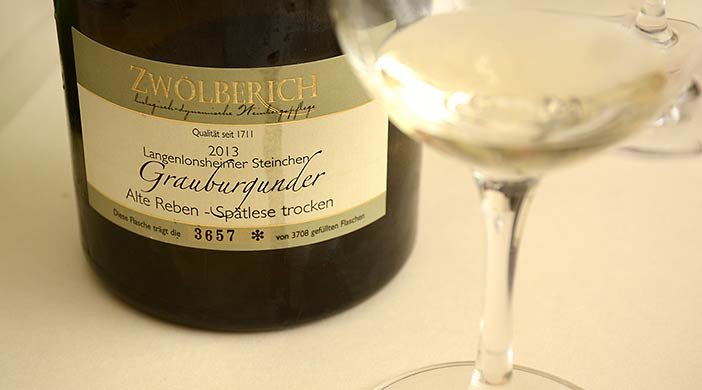
Zwölbericco
Hennon floral aromas. Fresh. Light. Pear-like. Light.
Auxerrois 2013
Pineapple. Grass. Citrusy and fresh aroma. Youthful, bouncy acidity. Peppery and long finish. Excellent wine. Best Auxerrois ever! A star.
Riesling 2013
Tropical aromas and an inviting sweetness of birch sap. Fruity. Subdued acidity. Fresh, mineral. Balanced. A bit unusual, but a good riesling.
LANGENLONSHEIMER STEINCHEN (GRAUB. ALTE REBE) 2013
Just tuneful. Aromatic. A bit of pineapple and soil. Dry, acidic and fresh. The wine opens up nicely over the next 10 minutes in the glass. Comes out a great wine, but not yet drinkable.
LANGENLONSHEIMER STEINCHEN (SPÄTBURGUNDER) 2013
Raspberry, cherry, some smoke. Havuja. Quite a robust wine. Spicy. Oaky as hell. Okay once you get the taste.
www.zwoelberich.de
Winery K.H.Schneider – a real discovery
Founded in 1956, the K.H.Schneider estate is located on the western edge of the Nahne wine region. The cellar itself is located in the idyllic little town of Bad Soberheim, and the 12 hectares of vines on the Marbach and Domberg parcels, which rise beautifully on the gently rolling hills beside the town, and a little further away on the Felsenberg of Schlossböckelheim.
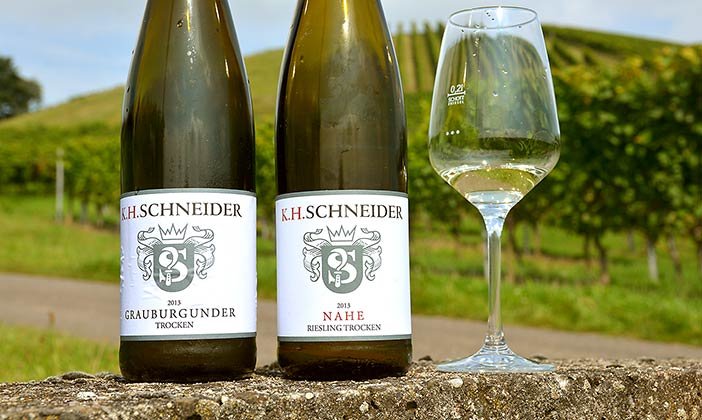
Schlossböckelheim lies atop an ancient volcano and the vineyards are perched on awkwardly steep slopes, but the soil for growing mineral Rieslings is excellent. In Marbach and Domberg, the soil is dominated by red glowing clay-slate Rotliegende, which gives these wines their distinctive aromas.

The third and most recent generational change at K.H.Schneider took place in 2007, with Andi and his brother Christian Schneider at the helm, well aware of what the world was craving. The farm still grows Riesling (40%) as the main grape, but the idea now is to harvest the grapes as early as possible, which gives the wines the maximum possible acidity, freshness and lightness – both in taste and alcohol content.
The vision works well. The style made an indelible impression on our group – the wines are very fresh and very elegant. Some of the best dry style Rieslings I’ve had the pleasure of tasting. And I’m not alone in my praise, Stuart Piggot, among others, named K.H Schneider “one of the year’s greatest discoveries”
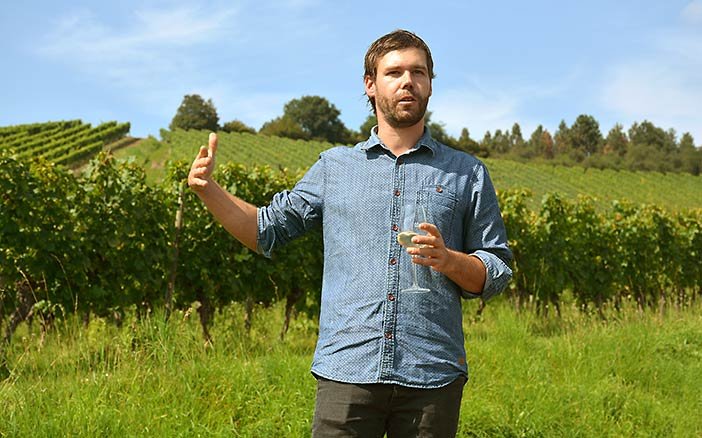
Riesling 2013
Rich and distinctive aromas. White currant. Birch. Fresh taste. Nice acidity. Clean. Light but intense. Dry. Very good and different riesling.
Sobernheimer Riesling – Roter Tonschiefer
Raspberry and white cherry. Rich but harmonious aromas. The taste is fresh and acidic. Dry. Light but firm. Long. A hint of soil minerals at the end. Absolutely brilliant.
Schlossböckelheimer Riesling Vulkanstein
Really interesting aromas again. Rhubarb and floral notes. Flavour is a little richer than above and rounder. The volcanic mineraliness nips at the tongue at the end, but in a very elegant way.
Marbach Riesling 2012
Dry green apple. Lemon and elegant kerosene. A meatier wine. Fine acidity. Long, slightly bitter mineral at the end.
Riesling Spätlese Domberg 2013
Rhubarb and honey. A little sticky. 90g sugar and good acidity. Nice balance. An elegant treat.
Riesling Auslese Marbach 2013
A more intense aroma. Apple and kerosene. 120g sugar and fine balance. Being young, it falls a little short. How to improve?
www.weingut-schneider.com
Bamberger – sparkling wine for four generations
Famed as the “sparkling wine expert” of the region, Bamberger farms 15 hectares on the steep slopes near the village of Meddersheimer. The style of wine-making brought by four generations is a legacy that the younger winemakers are carefully nurturing as they take over the reins. This includes rigorous crop limitation to obtain grapes of the highest quality and aroma.

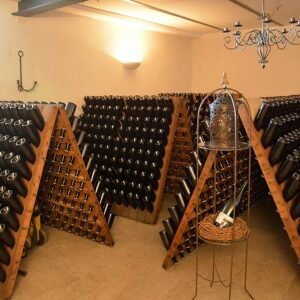
The sparkling wines are only used with the champagne method, even with a second fermentation of three years. The wines are swirled vertically, or “danced” with a hand-roll in their own cellar.
The main grapes used are Riesling (55%), Pinot Blanc, Pinot Gris, Rivaner and Gewürztraminer, which are divided into production not only by parcel, of course, but also by the altitude at which they are grown. On high slopes, there can be considerable differences in sugar content, depending on where you are on the slope.
Bamberger sparkling wine tasting
Riesling brut “The experienced” 2007
Fruity and toasted biscuit aromas. Hearty freshness. Directional, citric acidity. Balanced. Dry, but a little residual sugar completes the palate. A good sparkling wine that will clearly keep well for a few years in the cellar.
Cuvee Pinot Brut “prince Charming” 2011
Pinot Noir – Pinot Blanc blend. Two years of resting with yeasts. Gorgeous, reddish-brownish colour. Herbaceous and forest berry aromas. Balanced. Creamy. Medium acidity. Great mousse. Elegant rose.
Cuvee pinot -S- brut “Think big” 2010
Sweet and gooseberry aromas. A little bit of toast. Tropical fruit, complex, medium acidity and creamy. A fine sparkling wine.
Hexamer – the cradle of ageing Rieslings
A stone’s throw from the Bamberger house, in the “heart of Meddersheim”, where Friday afternoon rush hour meant one tractor and a cat scampering across the street, lie the basement premises of Hexamer. Harald Hexamer’s winemaking philosophy is surprisingly simple; quality. They invest in the soil and the grapes. They do as little as possible in the cellar.
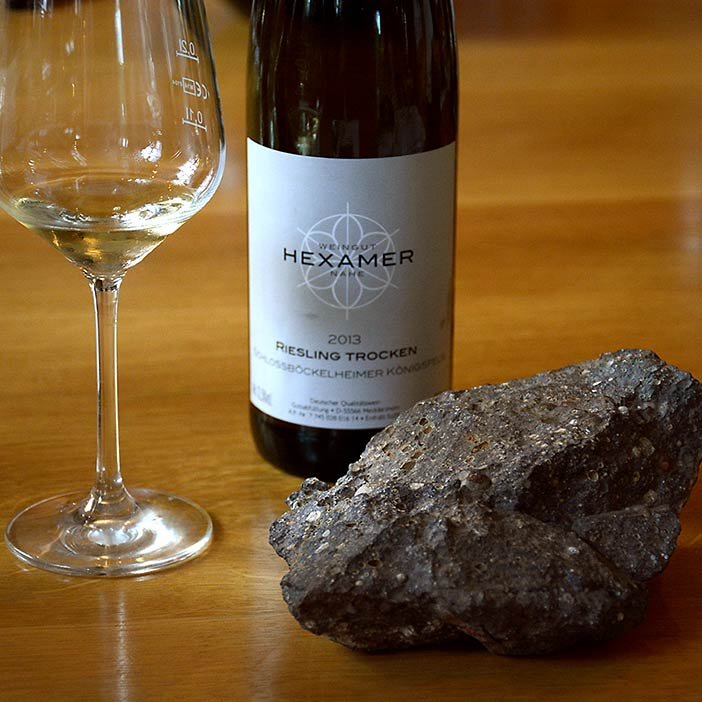
Harald Hexamer’s passion is wines with character. As a German winemaker, Riesling is of course his favourite because he says it best reflects the mineral-rich soil of the Nahe. The grapes are hand-picked, even twice, and as late as possible to ensure maximum ripe fruit. The grapes arrive in the cellar at less than ten degrees Celsius and are used very cold, preserving the wine’s freshness and acidity until bottling.
Harald Hexamer is particularly fond of aged Rieslings, which he collects as a “hobby”, to the extent that they needed a second cellar. For example, there are still 10 000 bottles of the 2004 vintage! The downside of this conversion was the cork stones, which Hexamer had enough of at an early stage. Weingut Hexamer was one of the first producers in Nane to switch to screw caps.

Weingut Hexamer in a nutshell
- 18 hectares
- 70,000 bottles per year
- Riesling (60%), Pinot Noir, Pinot Blanc, Pinot Gris, Pinot Madeleine, Müller-Thurgau, Gewürztraminer and Sauvignon Blanc
- Vineyards; Meddersheimer Rheingrafenberg (sandstone, quartz) and Schloßböckelheimer (ancient very high volcano with red rock spread all over the Nahe).
Weingut Hexamer wine tasting
Riesling Spätlese trocken 2004
Honey melon, apricot. Nicely developed aroma. Still fresh and acidic. Citrussy. Balanced. Long.
Weissburgunder trocken 2013
20% oak-aged. Slightly stale. Not at all expressive. Lacks the freshness and freshness of Pinot Blanc.
Riesling trocken Schloßböckelheimer Königsfels 2013
From one of the most prestigious (and valuable) parcels of volcanic land in the Nahe. Subtle fruity nose. Tropical. Pineapple. Herbs. Intense and acidic on the palate. Very mineral tingle on the tongue. Complex, quite muscular and interesting wine.
Riesling No. 1 Meddersheimer Rheingrafenberg 2013
Golden colour. Aroma of ripe apricot. Nice and balanced wine. Long acidity and finish. Elegant. Cellar stable for 20 years.
Sauvignon Blanc trocken 2013
Herbs, yes. Currants, yes. And a stunning stone flare on top. Quite a big entree, piquant, long and muesli viscous. Ripe, rather than fresh. A good and different Sauvignon Blanc.
Spätburgunder Blanc de Noir 2013
The nose is restrained but with intense forest berry. Nice acidity, balanced. Quite fair on the palate. Residual sugar and alcohol present. A good and different Spätburgunder.
Riesling Kabinett Meddersheimer Altenberg 2012
Petrol. Honey melon. Great balance of sweetness (58g/l) and acidity. Clear structure. Clean. Elegant and excellent wine.
weingut-hexamer.com
Weingut Montigny – red wine in the tank, rain or shine
A bit of a freak in Nane, Weingut Montigny grows mainly red grapes. Sacha Montigny is a second generation winemaker, although it was not until he started making wine proper. His parents grew grapes on the farm.

Red varieties, especially in rainy summers like now, are by no means easy to grow. St. Laurent in particular is quite susceptible to mildew. But in a good year, it produces wonderful and relatively rare wines. So every two years Sacha and his wife wonder why they don’t increase the acreage of St. Laurent, and every other year they are tearing up all the bushes…
There are also suspicions that global warming has led to the spread of a fly species from Asia that is spreading a new type of mould that is causing the tarmac to decay from the inside? This is an extremely vexing conundrum, because without opening it is impossible to tell which straw is rotten and which is good.
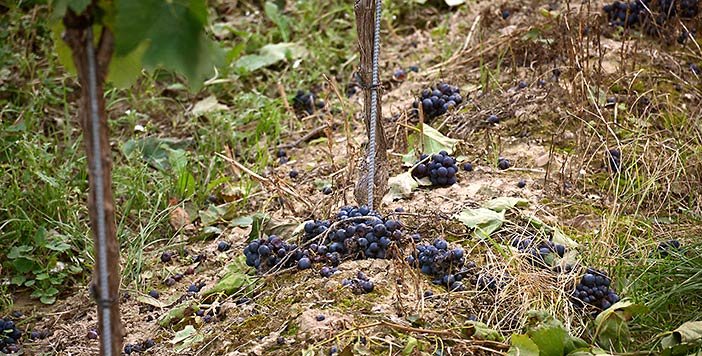
Weingut Montigny wine tasting
Saint Laurent Rose 2013
A delicate forest berry. Raspberry. Gorgeous colour. Light, fresh taste. Fine bubbles. Quite elegant.
2011 Saint Laurent
Lush, woody fragrance. Warm as a cow’s breath. Bitterly fresh on the palate. Vanilla. A hint of oak. Soft tannins. A great wine for lovers of the variety.
Frühburgunder trocken 2013
A fine dusting of berry and vanilla. Fruity, spicy, long and tannic.
Krone Spätburgunder 2012
Maple berry aromas. Blueberry. Vanilla. Warm breath. Young, medium-bodied, spicy. Delicate tannins.
Krone Spätburgunder 2010
Deeper and smoother than above. Still very spicy. Age is good.
montigny.de
Winery Marx – Nahes best Pinot Gris
Marx represents the dinosaurs of the Nahe wine family. The Marx have been growing wine in the region for 300 years. The current owner, Rainer Marx, and his family took over from his parents in 2005. Despite the long history, production has been kept moderate, to just 8 hectares, to maintain the touch of wine-making itself. Rainer says he is most comfortable in the vineyards or in the cellar. His wife takes care of the office side.
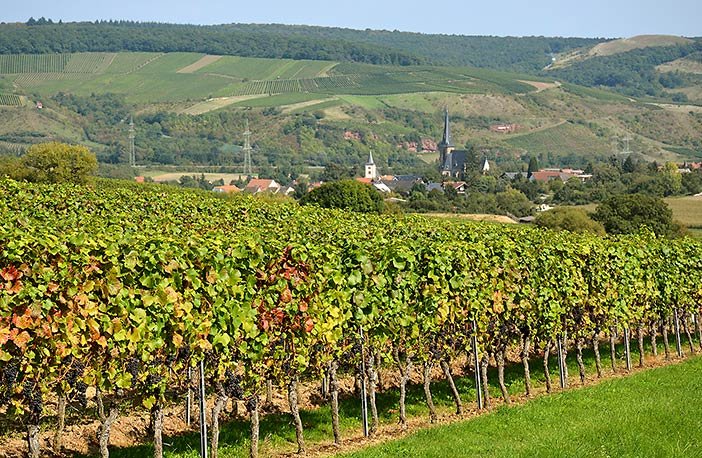
Despite the restrained size of the estate, Marx’s wines grow on several parcels and, in Nahe’s style, on several different soils. However, all the plots are close to the Windesheimer cellar, so the transport distance to harvest is not long. This is very important for Rainer Marx, who wants to produce wines with the purest possible flavour without too many sulphites or other gimmicks.
And indeed, the tasting showed that the gentleman has done well with a number of different grapes. Truly memorable and enjoyable wines, with the Pinot Gris “R” having won the title of the best Grauerburgunder in the Nahe a year ago.
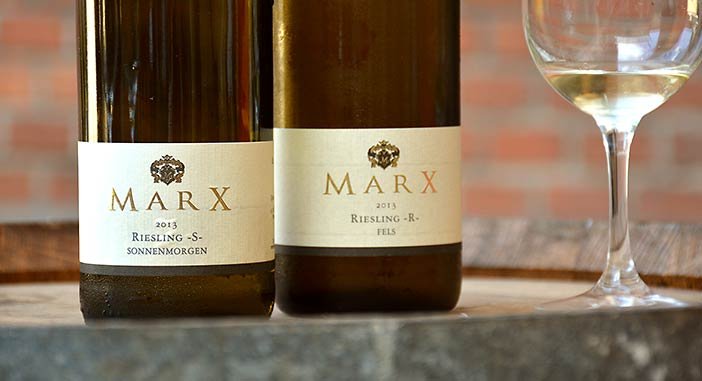
Winery Marx wine tasting
Marx’s wines also have a very recognizable aroma of currant-rhubarb, the same as K.H Schneider, dozens of kilometers away, which also had a lot of the red sandstone typical of Nahe.
WEISSER BURGUNDER “S” TROCKEN 2013
Rich. Currants and herbs. A lingering acidity folds nicely into the fruit. Long, herbal finish. Excellent Pinot Blanc.
GRAUER BURGUNDER TROCKEN 2013
An elegant, herbal aroma with white currant and rhubarb. Muscular. Great acidity. Balanced and velvety. Mineral finish. Would this be the best Pinot Gris I have tasted?
GRAUER BURGUNDER “R” TROCKEN 2013
Crowned with the best oak-aged Pinot Gris in the region. On the nose, rhubarb and vanilla. Elegant. Firm and creamy. There are acids too. A delicately peppery finish. Coming on really great in a year or two, but still young now.
RIESLING “S” SONNENMORGEN TROCKEN 2013
Familiar aromas, currant-rhubarb. Fruity, high acidity. Long and elegant.
RIESLING “R” FELS TROCKEN 2013
Aroma as above, but with a more mineral and bony body. Long and elegant still.
www.weingutmarx.com
Tour was held by the German Wine Institute.
Text and photos: Janne Suomi
This post is also available in:
Suomi

